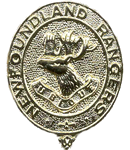Commemorated: | |||
| 1. Memorial: | Sailly-Saillisel British Cemetery | I. D. 2. | |
| 2. Book: | The (1921) Masonic Roll of Honour 1914-1918 | Pg.136 | |
| 3. Memorial: | The (1940) Scroll - WW1 Roll of Honour | 58A GQS | |
Awards & Titles: | |||
Family :
Son of Charles R. and Mary A. Thomson, of St. John's, Newfoundland.Service Life:
Campaigns:
- The First World War 1914-1918, World-wide.
| Unit / Ship / Est.: 1/Newfoundland Regiment |
| Action : Operations on the Ancre |
11 January - 13 March 1917. Operations on the Ancre concerned the gradual advance in the area around Miramont during which the Germans retired towards the Hindenburg Line defences.
Detail :
THOMSON, James Elliott, 2/Lieutenant, 1/Newfoundland Regiment On February 25 1917 the whole German front both north and south of the River Ancre collapsed for a depth of over three miles. The Germans retreated to their prepared second series of defensive positions whilst the British follow up was hampered by poor weather. Gradually the German retreat spread south, and on March 3, after scarcely more than a month of usual periodic trench duty and rest camp life, the Newfoundland Regiment was involved in an action at Saill-Saillisel, on the old Somme perimeter on the Transloy Ridges. The action was preceded by a terrific bombardment by the enemy of the position occupied by the Newfoundland Regiment. The bombardment started at 7 o'clock on the morning of March 3, and continued with increasing intensity for more than an hour. The Germans were concealed by a heavy mist and the use of smoke bombs. About 50 enemy troops advanced on each side of the trench occupied by the Newfoundlanders and were within about 700 yards before they were discovered. The situation called for quick action. Quite a number of the Newfoundlanders, including the platoon commander at that point, were so severely wounded during the bombardment that they were put out of action. A non-commissioned officer, who attempted to fire rockets as signals for aid, was severely wounded before he could send up more than two rockets. Fortunately an S. O. S. was telephoned to headquarters before communication by telephone was cut off. Every Lewis gun except one was put out of action. Bombs were used effectively by the Newfoundlanders, and three more Lewis guns were quickly brought up, but the enemy troops succeeded in getting into the trench and drove our men out for a distance of 40 yards, to the head of the communication trench. The situation was saved by two well arranged incidents. The British guns opened a heavy barrage about midway between the Newfoundland front line and the enemy front line. The barrage was highly successful in its purpose, in that it prevented more enemy troops from coming up. Lieutenant Gerald Byrne, who commanded a platoon farther to the left, took advantage of this situation. He quickly organized a bombing squad, and secured a supply of bombs. He personally led the attack up the trench, and with the aid of his party inflicted severe losses on the enemy and drove him out. The party then followed the enemy troops into their own territory, and drove them out of 60 yards of their front trench. The whole 100 yards were consolidated and held by the small party under Lieutenant Byrne despite heavy shell fire and bombing by the enemy. The prompt and courageous conduct of Lieutenant Byrne turned the part-enemy victory into a complete defeat, and Lieutenant Byrne was awarded the Military Cross for his splendid work and initiative in this engagement. Two other men, Private J. P. Lewis and Lance-Corporal M. Picco, were decorated for their conspicuous bravery during this action. Casualties in this action amounted to thirteen killed and thirty-nine wounded, and one of those killed was 2/Lieutenant James THOMSON. James THOMSON was initiated, passed and raised in WHITEWAY Lodge No 3541 on the same days as Cecil CLIFT (23rd May, 26th June and 7th July 1914). His occupation was a Foreman Mechanic. He enlisted into the Newfoundland Regiment on 2nd September 1914, being one of the ?First Five Hundred?. He served at Gallipoli where and then arrived in France with the battalion. He was promoted to Corporal then in June 1916 was commissioned as a 2/Lieutenant. A farewell gathering of masons took place in the Temple in St. John's on September 30, 1914 to bid farewell to the brethren going in the First Contingent to England. A similar event took place in 1915 when the brethren were presented with a special form of prayer to be used during the war. The brethren of all Lodges in Newfoundland contributed to the establishment of the Newfoundland Freemasons Ward of ten cots in a hospital in Southern England. Sources Official History Military Operations France & Belgium 1917 Vol I History of St John?s Lodge No 1; http://www.historyofsaintjohnslodgeno1.blogspot.com/
Masonic :
| Type | Lodge Name and No. | Province/District : |
|---|---|---|
| Mother : | Whiteway Lodge No. 3541 E.C. | Newfoundland |
Initiated | Passed | Raised |
23rd May 1914 | 26th June 1914 | 7th July 1914 |
Listed as a 22 year old Foreman Mechanic resident at St. John's. Three years of war service is shown in the contribution register followed by "Killed on W.S. 3.3.17."
Source :
The project globally acknowledges the following as sources of information for research across the whole database:
- The Commonwealth War Graves Commission
- The (UK) National Archives
- Ancestry.co.uk - Genealogy, Family Trees & Family History online
- ugle.org.uk - The records of the United Grand Lodge of England including the Library and Museum of Freemasonry
Additional Source:
- Founder Researchers : Paul Masters & Mike McCarthy
- Researcher : Bruce Littley

